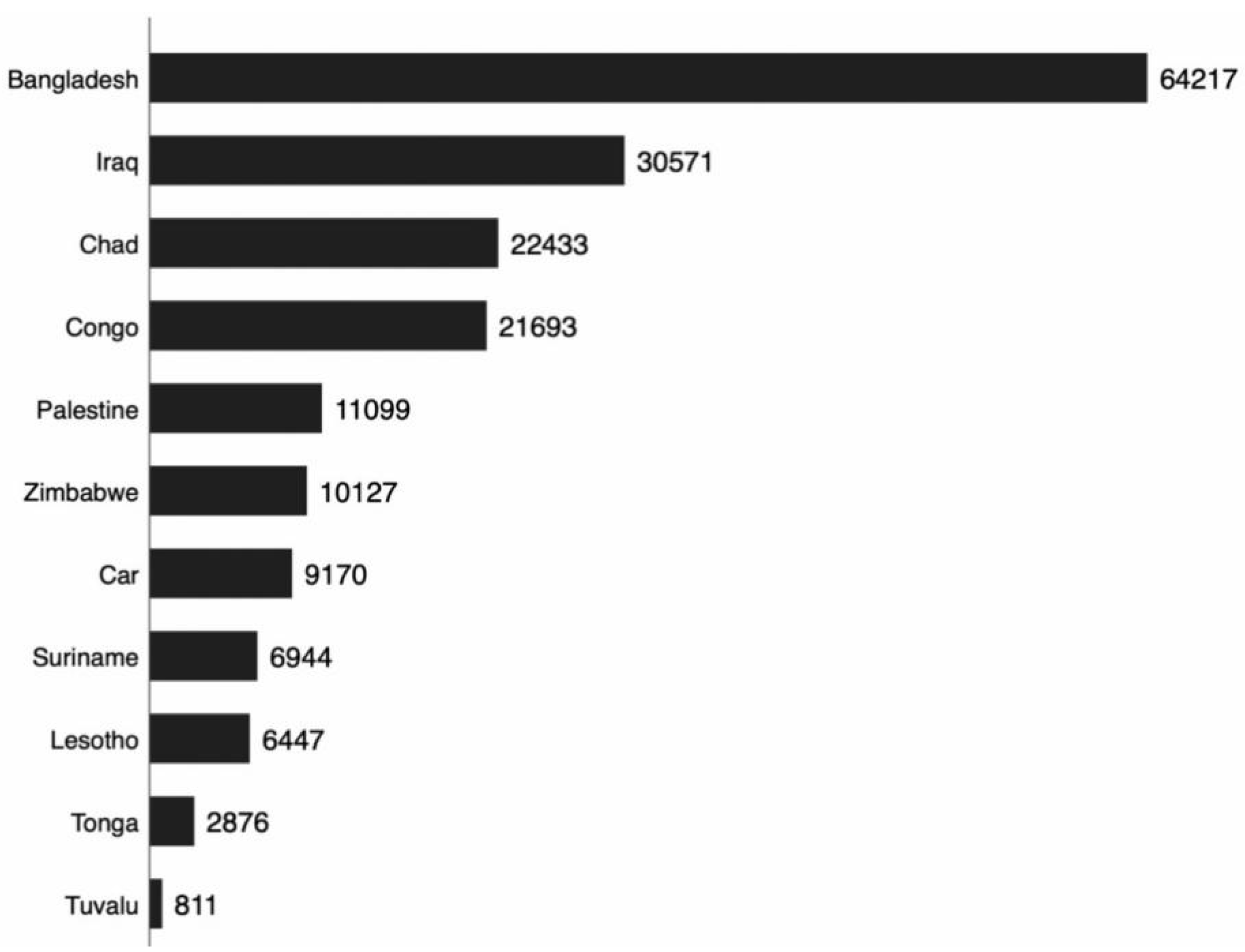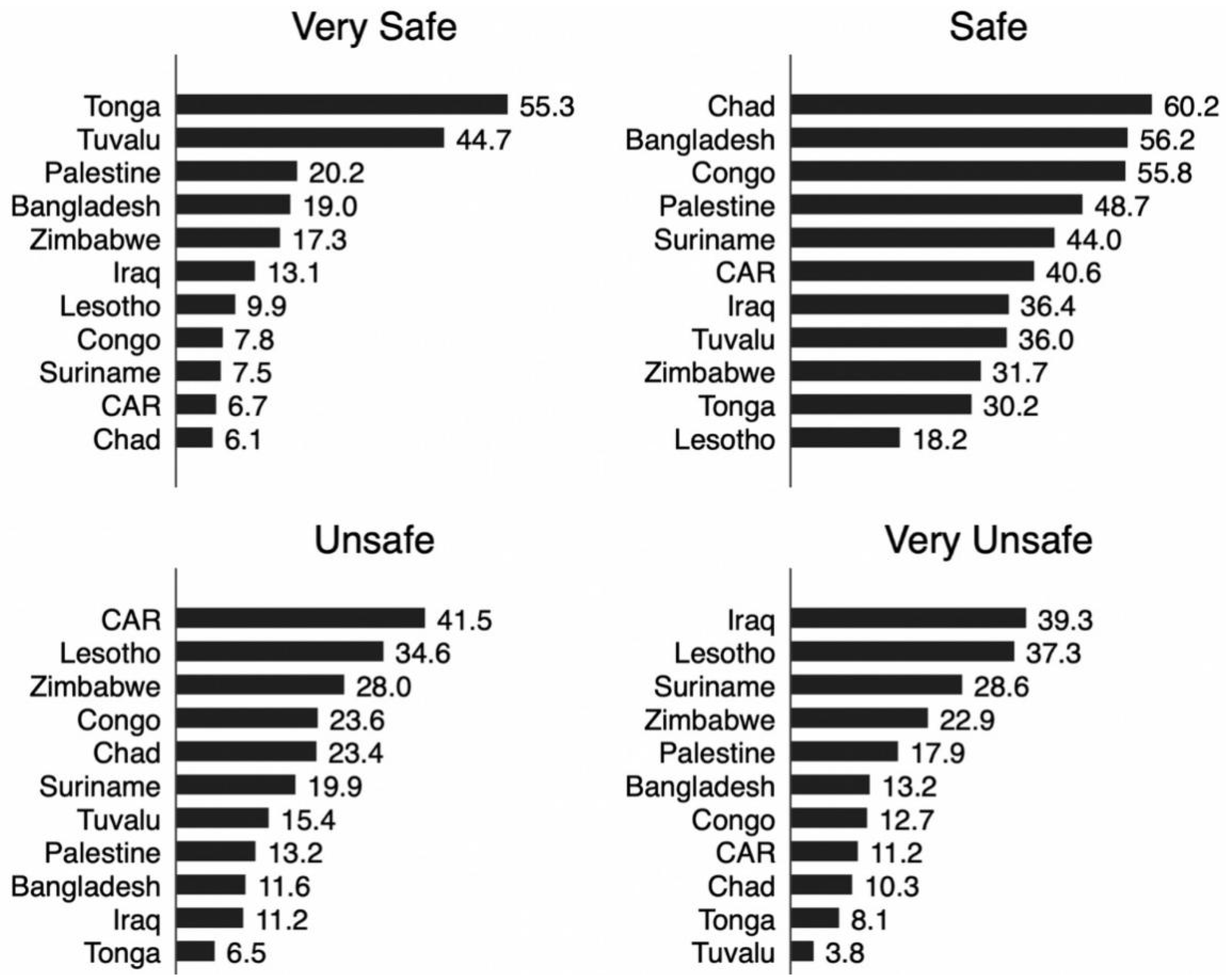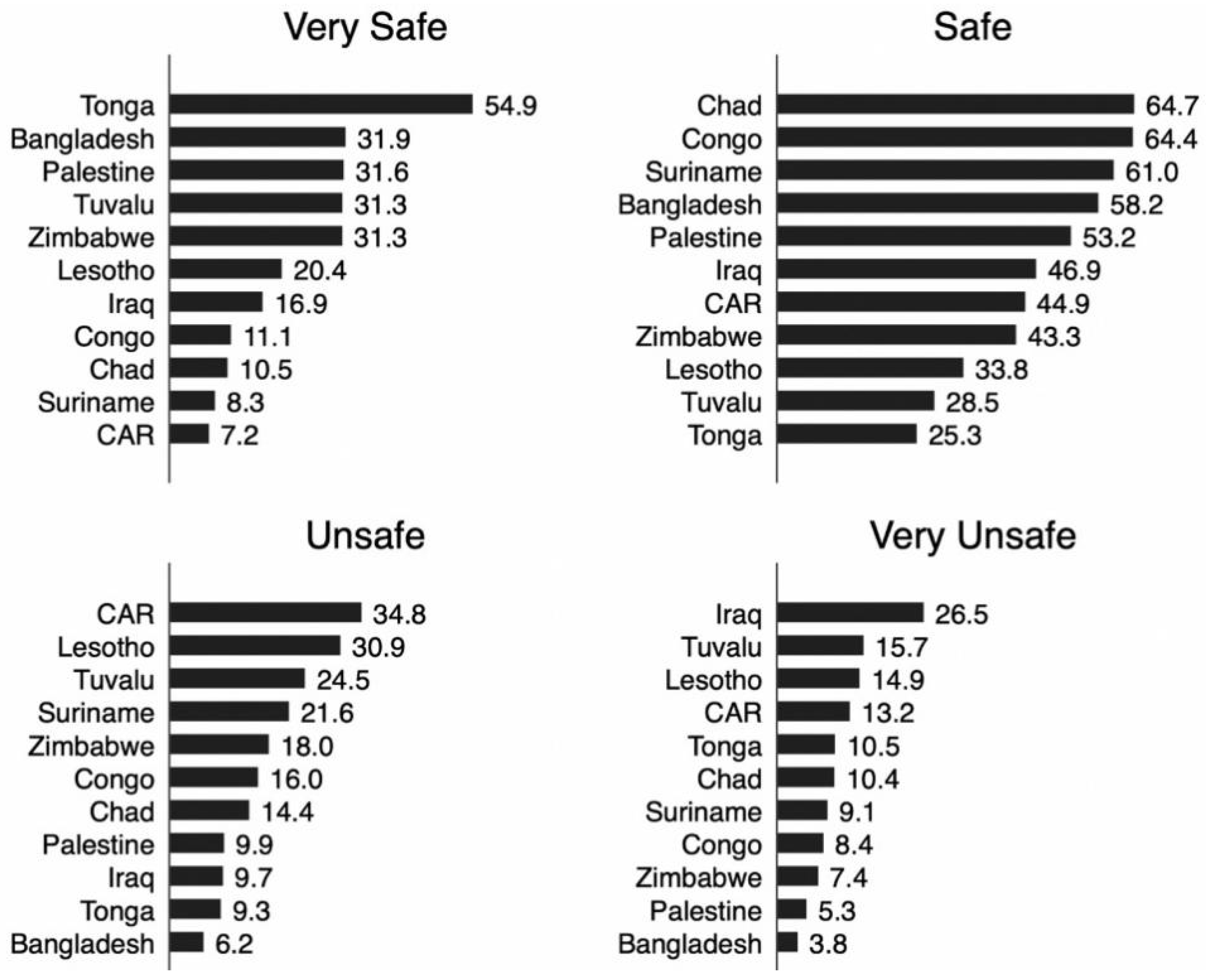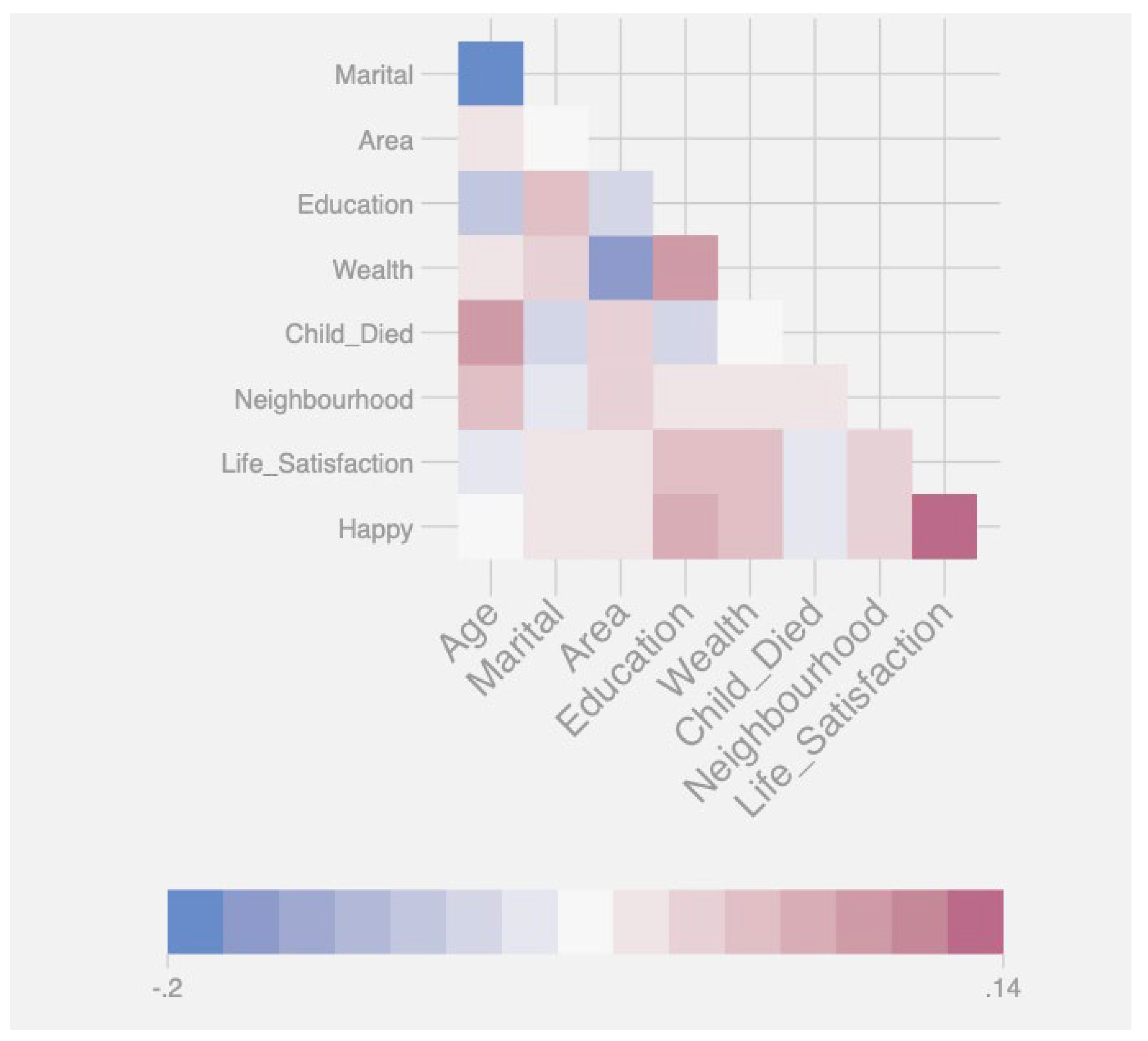Relationship between Self-Reported Neighborhood Safety and Happiness and Life Satisfaction among Women in Low-Middle Income Countries
Abstract
:1. Introduction
2. Materials and Methods
2.1. Variables Used in the Study
2.2. Data Analysis
3. Results
4. Discussion
5. Conclusions
Author Contributions
Funding
Institutional Review Board Statement
Acknowledgments
Conflicts of Interest
Appendix A
| Age Groups | Percent | Cum. |
|---|---|---|
| 15–19 | 18.7 | 18.7 |
| 20–24 | 16.45 | 35.15 |
| 25–29 | 16.07 | 51.22 |
| 30–34 | 15.44 | 66.66 |
| 35–39 | 13.71 | 80.36 |
| 40–44 | 10.66 | 91.03 |
| 45–49 | 8.97 | 100 |
| Currently Married | Percent | Cum. |
| Yes | 77.87 | 77.87 |
| No | 22.13 | 100 |
| Area type | Percent | Cum. |
| Urban | 34.02 | 34.02 |
| Rural | 65.98 | 100 |
| Education | Percent | Cum. |
| Up To Primary | 27.74 | 27.74 |
| Secondary | 31.95 | 59.69 |
| Higher | 40.31 | 100 |
| Household Wealth quantile | Percent | Cum. |
| Poorest | 20.3 | 20.3 |
| Second | 19.87 | 40.17 |
| Middle | 20.22 | 60.39 |
| Fourth | 19.64 | 80.03 |
| Richest | 19.97 | 100 |
| Any Child ever died | Percent | Cum. |
| No | 89.1 | 89.1 |
| One | 7.91 | 97.01 |
| >one | 2.99 | 100 |
| Neighbourhood safety | Percent | Cum. |
| Very Safe | 14.50 | 14.50 |
| Safe | 48.59 | 63.09 |
| Unsafe | 17.85 | 80.93 |
| Very Unsafe | 19.07 | 100.00 |
| Feels unsafe at home | Percent | Cum. |
| Very Safe | 29.35 | 29.35 |
| Safe | 65.88 | 95.23 |
| Unsafe | 2.63 | 97.87 |
| Very Unsafe | 2.13 | 100.00 |
References
- Kimm, H.; Sull, J.W.; Gombojav, B.; Yi, S.-W.; Ohrr, H. Life satisfaction and mortality in elderly people: The Kangwha Cohort Study. BMC Public Health 2012, 12, 54. [Google Scholar] [CrossRef] [PubMed] [Green Version]
- Feller, S.; Teucher, B.; Kaaks, R.; Boeing, H.; Vigl, M. Life Satisfaction and Risk of Chronic Diseases in the European Prospective Investigation into Cancer and Nutrition (EPIC)-Germany Study. PLoS ONE 2013, 8, e73462. [Google Scholar] [CrossRef] [PubMed]
- Huang, R.; Ghose, B.; Tang, S. Effect of financial stress on self-rereported health and quality of life among older adults in five developing countries: A cross sectional analysis of WHO-SAGE survey. BMC Geriatr. 2020, 20, 288. [Google Scholar] [CrossRef] [PubMed]
- He, Z.; Cheng, Z.; Bishwajit, G.; Zou, D. Wealth Inequality as a Predictor of Subjective Health, Happiness and Life Satisfaction among Nepalese Women. Int. J. Environ. Res. Public Health 2018, 15, 2836. [Google Scholar] [CrossRef] [Green Version]
- Koivumaa-Honkanen, H.; Honkanen, R.; Viinamäki, H.; Heikkilä, K.; Kaprio, J.; Koskenvuo, M. Self-reported life satisfaction and 20-year mortality in healthy Finnish adults. Am. J. Epidemiol. 2000, 152, 983–991. [Google Scholar] [CrossRef] [Green Version]
- Gan, Y. Happy People Live Longer and Better: Advances in Research on Subjective Well-Being. Appl. Psychol. Health Well-Being 2020, 12, 3–6. [Google Scholar] [CrossRef] [PubMed]
- Bennett, G.G.; McNeill, L.H.; Wolin, K.Y.; Duncan, D.T.; Puleo, E.; Emmons, K.M. Safe to walk? Neighborhood safety and physical activity among public housing residents. PLoS Med. 2007, 4, 1599–1606; discussion 1607. [Google Scholar] [CrossRef] [Green Version]
- Kerr, Z.; Evenson, K.R.; Moore, K.; Block, R.; Diez Roux, A.V. Changes in Walking Associated with Perceived Neighborhood Safety and Police-Recorded Crime: The Multi-Ethnic Study of Atherosclerosis. Prev. Med. 2015, 73, 88–93. [Google Scholar] [CrossRef] [Green Version]
- Carver, A.; Timperio, A.; Crawford, D. Playing it safe: The influence of neighbourhood safety on children’s physical activity. A review. Health Place 2008, 14, 217–227. [Google Scholar] [CrossRef]
- An, R.; Yang, Y.; Hoschke, A.; Xue, H.; Wang, Y. Influence of Neighborhood Safety on Childhood Obesity: A Systematic Review and Meta-analysis of Longitudinal Studies. Obes. Rev. Off. J. Int. Assoc. Study Obes. 2017, 18, 1289–1309. [Google Scholar] [CrossRef]
- Tung, E.L.; Boyd, K.; Lindau, S.T.; Peek, M.E. Neighborhood crime and access to health-enabling resources in Chicago. Prev. Med. Rep. 2018, 9, 153–156. [Google Scholar] [CrossRef]
- For Girls, Success Starts with Safe Schools. Women Deliver. 2016. Available online: https://womendeliver.org/2016/for-girls-success-starts-with-safe-schools/ (accessed on 23 October 2021).
- Mori, Y.; Tiiri, E.; Khanal, P.; Khakurel, J.; Mishina, K.; Sourander, A. Feeling Unsafe at School and Associated Mental Health Difficulties among Children and Adolescents: A Systematic Review. Children 2021, 8, 232. [Google Scholar] [CrossRef]
- Meyer, S.R.; Yu, G.; Hermosilla, S.; Stark, L. School violence, perceptions of safety and school attendance: Results from a cross-sectional study in Rwanda and Uganda. J. Glob. Health Rep. 2018, 2, e2018020. [Google Scholar] [CrossRef] [PubMed]
- Buh, A.; Kota, K.; Bishwajit, G.; Yaya, S. Prevalence and Associated Factors of Taking Intermittent Preventive Treatment in Pregnancy in Sierra Leone. Trop. Med. Infect. Dis. 2019, 4, 32. [Google Scholar] [CrossRef] [Green Version]
- Khan, S.; Hancioglu, A. Multiple Indicator Cluster Surveys: Delivering Robust Data on Children and Women across the Globe. Stud. Fam. Plann. 2019, 50, 279–286. [Google Scholar] [CrossRef] [Green Version]
- Al Hilfi, T.K.Y. Toward a Healthier Iraq. Yale J. Biol. Med. 2014, 87, 289–297. [Google Scholar] [PubMed]
- Robinson, E.; Lee, L.; Roberts, L.F.; Poelhekke, A.; Charles, X.; Ouabo, A.; Vyncke, J.; Ariti, C.; Gbanzi, M.C.A.; Ouakouma, M.T.; et al. Mortality beyond emergency threshold in a silent crisis—Results from a population-based mortality survey in Ouaka prefecture, Central African Republic, 2020. Confl. Health 2021, 15, 50. [Google Scholar] [CrossRef] [PubMed]
- Tinker, A. Women’s health: The unfinished agenda. Int. J. Gynaecol. Obstet. Off. Organ Int. Fed. Gynaecol. Obstet. 2000, 70, 149–158. [Google Scholar] [CrossRef]
- Mendenhall, E.; Weaver, L.J. Reorienting women’s health in low- and middle-income countries: The case of depression and Type 2 diabetes. Glob. Health Action 2014, 7, 22803. [Google Scholar] [CrossRef] [Green Version]
- Liu, E.; Iwelunmor, J.; Gabagaya, G.; Anyasi, H.; Leyton, A.; Goraleski, K.A.; Wei, S.; del Barrio, M.O.; Olaleye, A.; Launois, P.; et al. Women’s global health leadership in LMICs. Lancet Glob. Health 2019, 7, E1172–E1173. [Google Scholar] [CrossRef] [Green Version]
- McDonald, C.R.; Weckman, A.M.; Wright, J.K.; Conroy, A.L.; Kain, K.C. Pregnant Women in Low- and Middle-Income Countries Require a Special Focus During the COVID-19 Pandemic. Front. Glob. Womens Health 2020, 1, 6. [Google Scholar] [CrossRef] [PubMed]
- Myers, S.R.; Branas, C.C.; French, B.C.; Nance, M.L.; Kallan, M.J.; Wiebe, D.J.; Carr, B.G. Safety in numbers: Are major cities the safest places in the United States? Ann. Emerg. Med. 2013, 62, 408–418.e3. [Google Scholar] [CrossRef] [Green Version]
- Government of Canada, Statistics Canada. Police-Reported Crime in Rural and Urban Areas in the Canadian Provinces, 2017. 2019. Available online: https://www150.statcan.gc.ca/n1/pub/85-002-x/2019001/article/00009-eng.htm (accessed on 23 October 2021).
- Helliwell, J.F.; Shiplett, H.; Barrington-Leigh, C.P. How Happy are Your Neighbours? Variation in Life Satisfaction among 1200 Canadian Neighbourhoods and Communities; Working Paper; National Bureau of Economic Research: Cambridge, MA, USA, 2018. [Google Scholar] [CrossRef]
- Gruebner, O.; Rapp, M.A.; Adli, M.; Kluge, U.; Galea, S.; Heinz, A. Cities and Mental Health. Dtsch. Ärztebl. Int. 2017, 114, 121. [Google Scholar] [CrossRef] [PubMed] [Green Version]
- Blue, I.; Harpham, T. Urbanization and mental health in developing countries. Curr. Issues Public Health 1996, 2, 181–185. [Google Scholar]
- Galea, S.; Uddin, M.; Koenen, K. The urban environment and mental disorders. Epigenetics 2011, 6, 400–404. [Google Scholar] [CrossRef] [PubMed] [Green Version]
- Cramm, J.M.; Nieboer, A.P. Relationships between frailty, neighborhood security, social cohesion and sense of belonging among community-dwelling older people. Geriatr. Gerontol. Int. 2013, 13, 759–763. [Google Scholar] [CrossRef]
- Cramm, J.M.; Nieboer, A.P. Neighborhood attributes security and solidarity promote the well-being of community-dwelling older people in the Netherlands. Geriatr. Gerontol. Int. 2014, 14, 681–688. [Google Scholar] [CrossRef] [PubMed]




| Worse vs. Improved | Worse vs. Same | |||||
|---|---|---|---|---|---|---|
| Full Sample | Urban | Rural | Full Sample | Urban | Rural | |
| Neighborhood (Very Unsafe) | ref | ref | ref | ref | ref | ref |
| Safe | 0.95 | 0.95 | 0.95 | 1.07 | 1.08 | 1.02 |
| [0.89, 1.02] | [0.89, 1.02] | [0.89, 1.02] | [0.99, 1.15] | [0.99, 1.18] | [0.92, 1.13] | |
| Unsafe | 1.37 *** | 1.25 *** | 1.46 *** | 1.21 ** | 1.22 *** | 1.47 *** |
| [1.31, 1.43] | [1.15, 1.35] | [1.38, 1.55] | [1.28, 1.46] | [1.10, 1.37] | [1.36, 1.60] | |
| Very Unsafe | 1.43 *** | 1.32 *** | 1.49 *** | 1.57 *** | 1.38 *** | 1.66 *** |
| [1.36, 1.50] | [1.22, 1.44] | [1.40, 1.58] | [1.46, 1.67] | [1.22, 1.54] | [1.53, 1.80] | |
| Home (Very safe) | ref | ref | ref | ref | ref | ref |
| Safe | 1.01 | 1.00 | 1.01 | 0.90 *** | 0.95 | 0.87 *** |
| [0.97, 1.04] | [0.94, 1.07] | [0.96, 1.05] | [0.86, 0.94] | [0.87, 1.03] | [0.82, 0.93] | |
| Unsafe | 1.10 *** | 1.12 ** | 1.08 * | 0.95 | 0.94 | 0.98 |
| [1.04, 1.15] | [1.04, 1.22] | [1.01, 1.15] | [0.89, 1.02] | [0.84, 1.05] | [0.90, 1.06] | |
| Very Unsafe | 1.13 *** | 1.25 *** | 1.07 * | 1.12 *** | 1.22 *** | 1.23 ** |
| [1.08, 1.19] | [1.15, 1.35] | [1.01, 1.13] | [1.05, 1.19] | [1.09, 1.35] | [1.07, 1.43] | |
| Unhappy vs. Happy | Unhappy vs. Neither | |||||
|---|---|---|---|---|---|---|
| Full Sample | Urban | Rural | Full Sample | Urban | Rural | |
| Neighbourhood (Very Unsafe) | ref | ref | ref | ref | ref | ref |
| Safe | 1.12 *** | 1.20 *** | 1.08 * | 1.02 | 1.1 | 0.98 |
| [1.06, 1.17] | [1.10, 1.30] | [1.02, 1.15] | [0.94, 1.10] | [0.95, 1.26] | [0.89, 1.08] | |
| Unsafe | 1.44 *** | 1.49 *** | 1.40 *** | 1.22 *** | 1.32 *** | 1.02 |
| [1.36, 1.52] | [1.36, 1.64] | [1.31, 1.50] | [1.12, 1.33] | [1.13, 1.53] | [0.92, 1.13] | |
| Very Unsafe | 1.16 *** | 1.29 *** | 1.10 ** | 1.08 | 1.23 ** | 1.17 ** |
| [1.10, 1.22] | [1.18, 1.41] | [1.03, 1.18] | [0.99, 1.18] | [1.07, 1.43] | [1.05, 1.29] | |
| Home (Very safe) | ref | ref | ref | ref | ref | ref |
| Safe | 1.28 *** | 1.27 *** | 1.28 *** | 1.36 *** | 1.30 *** | 1.39 *** |
| [1.23, 1.33] | [1.19, 1.37] | [1.22, 1.35] | [1.28, 1.46] | [1.15, 1.45] | [1.28, 1.51] | |
| Unsafe | 1.54 *** | 1.37 *** | 1.65 *** | 1.85 *** | 1.51 *** | 2.07 *** |
| [1.46, 1.62] | [1.25, 1.50] | [1.54, 1.76] | [1.71, 2.01] | [1.31, 1.74] | [1.87, 2.29] | |
| Very Unsafe | 1.65 *** | 1.55 *** | 1.71 *** | 1.88 *** | 1.63 *** | 2.01 *** |
| [1.57, 1.74] | [1.42, 1.69] | [1.60, 1.82] | [1.74, 2.03] | [1.43, 1.87] | [1.82, 2.21] | |
Publisher’s Note: MDPI stays neutral with regard to jurisdictional claims in published maps and institutional affiliations. |
© 2022 by the authors. Licensee MDPI, Basel, Switzerland. This article is an open access article distributed under the terms and conditions of the Creative Commons Attribution (CC BY) license (https://creativecommons.org/licenses/by/4.0/).
Share and Cite
Ghose, B.; Etowa, J. Relationship between Self-Reported Neighborhood Safety and Happiness and Life Satisfaction among Women in Low-Middle Income Countries. Safety 2022, 8, 31. https://doi.org/10.3390/safety8020031
Ghose B, Etowa J. Relationship between Self-Reported Neighborhood Safety and Happiness and Life Satisfaction among Women in Low-Middle Income Countries. Safety. 2022; 8(2):31. https://doi.org/10.3390/safety8020031
Chicago/Turabian StyleGhose, Bishwajit, and Josephine Etowa. 2022. "Relationship between Self-Reported Neighborhood Safety and Happiness and Life Satisfaction among Women in Low-Middle Income Countries" Safety 8, no. 2: 31. https://doi.org/10.3390/safety8020031
APA StyleGhose, B., & Etowa, J. (2022). Relationship between Self-Reported Neighborhood Safety and Happiness and Life Satisfaction among Women in Low-Middle Income Countries. Safety, 8(2), 31. https://doi.org/10.3390/safety8020031





